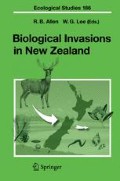Access this chapter
Tax calculation will be finalised at checkout
Purchases are for personal use only
Preview
Unable to display preview. Download preview PDF.
References
Bond WJ, Lee WG, Craine JM (2004) Plant structural defences against browsing birds: a legacy of New Zealand’s extinct moas. Oikos 104:500–508
Craine JM, Lee WG (2003) Covariation in leaf and root traits for native and non-native grasses during an altitudinal gradient in New Zealand. Oecologia 134:471–478
Davis MA, Pelsor M (2001) Experimental support for a resource-based mechanistic model of invasibility. Ecol Lett 4:421–428
Elton CS (1958) The ecology of invasions by animals and plants. Methuen, London
Fargione J, Brown CS, Tilman D (2003) Community assembly and invasion: An experimental test of neutral versus niche processes. Proc Natl Acad Sci USA 100:8916–8920
Guthrie-Smith H (1921) Tutira: the story of a New Zealand sheep station. Blackwood, London
Hector A, Dobson K, Minns A, Bazeley-White E, Lawton JH (2001) Community diversity and invasion resistance: an experimental test in a grassland ecosystem and a review of comparable studies. Ecol Res 16:819–831
Johnson PN, Rogers GM (2003). Ephemeral wetlands and their turfs in New Zealand. Department of Conservation, Wellington, New Zealand
Kissel RM, Wilson JB, Bannister P, Mark AF (1987) Water relations of some native and exotic shrubs of New Zealand. New Phytol 107:29–37
Kolar CS, Lodge DM (2001) Progress in invasion biology: predicting invaders. Trends Ecol Evol 16:199–204
Lee KE (1959) The earthworm fauna of New Zealand. DSIR Bull 130. Wellington, New Zealand
Lee WG, Fenner M, Loughnan A, Lloyd KM (2000) Long-term effects of defoliation: incomplete recovery of a New Zealand alpine tussock grass, Chionochloa pallens, after 20 years. J Appl Ecol 37:348–355
Lee DE, Lee WG, Mortimer N (2001) Where and why have all the flowers gone? Depletion and turnover in the New Zealand Cenozoic angiosperm flora in relation to palaeogeography and climate. Aust J Bot 49:341–356
Lloyd KM, Lee WG, Wilson JB (2002) Competitive abilities of rare and common plants: comparisons using Acaena (Rosaceae) and Chionochloa (Poaceae) from New Zealand. Conserv Biol 16:975–985
Lodge DM (1993) Biological invasions: lessons for ecology. Trends Ecol Evol 8:133–137
MacArthur RH, Wilson EO (1967) The theory of island biogeography. Princeton Univ Press, Princeton, NJ
McGlone MS (2001) The origin of the indigenous grasslands of southeastern South Island in relation to pre-human woody ecosystems. NZ J Ecol 25(1):1–15
McGlone MS, Dungan RJ, Hall GMJ, Allen RB (2004) Winter leaf loss in the New Zealand woody flora. NZ J Bot 42:1–19
Miller TE, Kneitel JM, Burns JH (2002) Effect of community structure on invasion success and rate. Ecology 83:898–905
Mooney HA, Drake JA (1986) Ecology of biological invasions of North America and Hawaii. Ecological Studies Analysis and Synthesis, vol 58. Springer, Berlin Heidelberg New York
O’Connor KF (1980) The use of mountains: a review of New Zealand experience. In: Anderson AG (ed) The land our future: essays on land use and conservation in New Zealand in honour of Kenneth Cumberland. Longman Paul/New Zealand Geographical Society, Auckland, New Zealand, pp 193–222
Olden JD, Poff NL (2003) Toward a mechanistic understanding and prediction of biotic homogenization. Am Nat 162:442–460
Pheloung PC, Williams PA, Halloy SR (1999) A weed risk assessment model for use as a biosecurity tool evaluating plant introductions. J Environ Manage 57:239–252
Reich PB, Buschena C, Tjoelker MG, Wrage K, Knops J, Tilman D, Machado JL (2003) Variation in growth rate and ecophysiology among 34 grassland and savanna species under contrasting N supply: a test of functional group differences. New Phytol 157:617–631
Robinson GR, Quinn JF, Stanton ML (1995) Invasibility of experimental habitat islands in a California winter annual grassland. Ecology 76:786–794
Rogers G, Walker S, Tubbs M, Henderson J (2002) Ecology and conservation status of three “spring annual” herbs in dryland ecosystems of New Zealand. NZ J Bot 40:649–669
Verheyen K, Vellend M, van Calster H, Peterken G, Hermy M (2004) Metapopulation dynamics in changing landscapes: a new spatially realistic model for forest plants. Ecology 85:3302–3312
Walker S, Lee WG (2000) Alluvial grasslands in south-eastern New Zealand: vegetation patterns, long-term and post-pastoral change. J R Soc NZ 30:69–103
Walker S, Wilson JB, Lee WG (2003) Recovery of short tussock and woody species guilds in ungrazed Festuca novae-zelandiae short tussock grassland with fertiliser or irrigation. NZ J Ecol 27:179–189
Wardle P (1985) New Zealand timberlines. 3. A synthesis. NZ J Bot 23:263–271
Wardle P (1991) Vegetation of New Zealand. Cambridge Univ Press, Cambridge
Williamson M (1999) Invasions. Ecography 22:5–12
Wiser SK, Allen RB, Clinton PW, Platt KH (1998) Community structure and forest invasion by an exotic herb over 23 years. Ecology 79:2071–2081
Wiser SK, Bellingham PJ, Burrows LE (2001) Managing biodiversity information: development of New Zealand’s National Vegetation Survey databank. NZ J Ecol 25(2):1–17
Author information
Authors and Affiliations
Editor information
Editors and Affiliations
Rights and permissions
Copyright information
© 2006 Springer-Verlag Berlin Heidelberg
About this chapter
Cite this chapter
Craine, J.M., Lee, W.G., Walker, S. (2006). The Context of Plant Invasions in New Zealand: Evolutionary History and Novel Niches. In: Allen, R.B., Lee, W.G. (eds) Biological Invasions in New Zealand. Ecological Studies, vol 186. Springer, Berlin, Heidelberg. https://doi.org/10.1007/3-540-30023-6_11
Download citation
DOI: https://doi.org/10.1007/3-540-30023-6_11
Publisher Name: Springer, Berlin, Heidelberg
Print ISBN: 978-3-540-30022-9
Online ISBN: 978-3-540-30023-6
eBook Packages: Biomedical and Life SciencesBiomedical and Life Sciences (R0)

